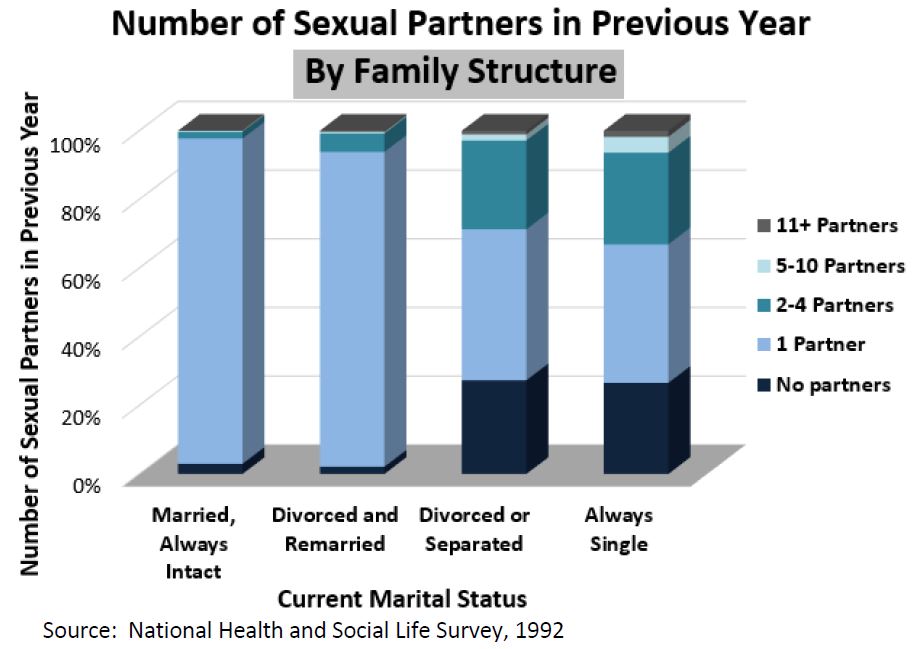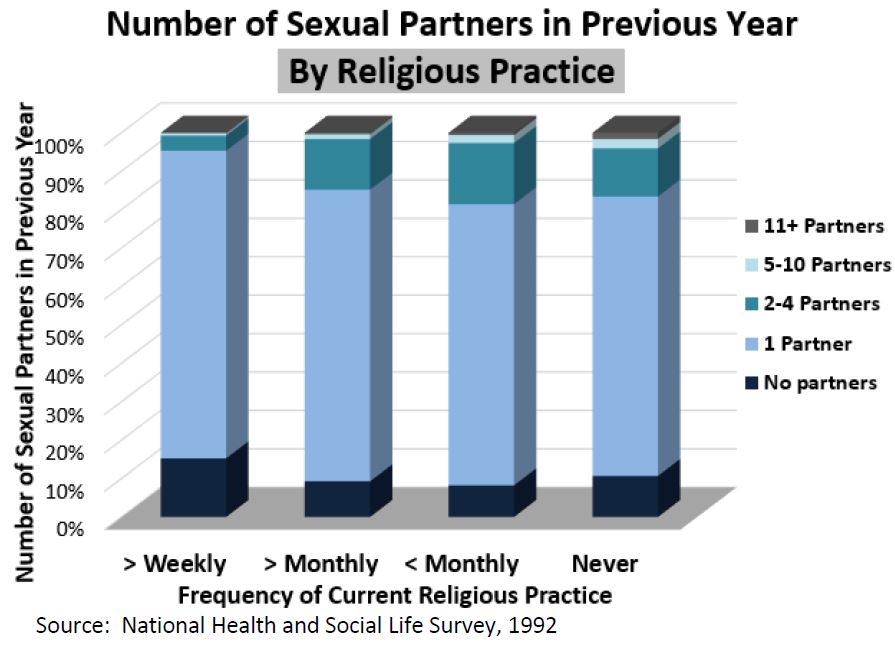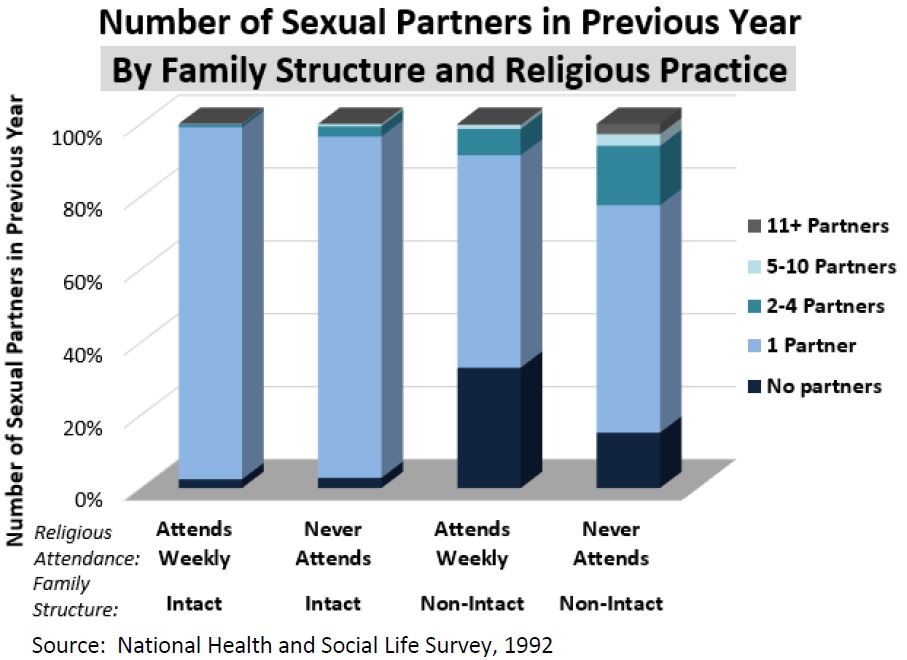Click Here to download “Number of Sexual Partners in Previous Year by Family Structure and Religious Practice”
Number of Sexual Partners in Previous Year by Family Structure and Religious Practice
The 1992 National Health and Social Life Survey shows that, of adults aged 18 to 59, those in intact marriages who worshipped weekly had the lowest number of sexual partners in the previous year.
[1]
Family Structure: Those in always-intact marriages had the largest percentage of monogamous/abstinent persons. Nearly 95 percent of individuals in intact marriages had only one sexual partner in the previous year, and 3 percent had no sexual partners (a combined 97.7 percent of monogamous/abstinent persons). Nearly 92 percent of individuals who had divorced and remarried had only one sexual partner in the previous year, and 2.1 percent had no sexual partners (a combined 93.8 percent of monogamous/abstinent persons). Forty-four percent of those who were divorced or separated had only one sexual partner in the previous year, and 27.3 percent had no sexual partners (a combined 71.3 percent of monogamous/abstinent persons). Over 40 percent of always-single individuals had only one sexual partner in the previous year, and 26.6 percent had no sexual partners (a combined 66.9 percent of monogamous/abstinent persons).
Those in always-intact marriages also had the smallest percentage of persons with 11 or more sexual partners in the previous year: zero percent reported 11 or more sexual partners, compared to .3 percent of those who were divorced and remarried, 1.1 percent of those who were divorced or separated, and 1.8 percent of those who were always single.
 Religious Practice:
Religious Practice: The “worships weekly” category contained the largest percentage of monogamous/abstinent persons. Approximately 80 percent of those who worshipped weekly at the time of the survey had only one sexual partner in the previous year, and 15.3 percent had no sexual partners (a combined 95.3 percent of monogamous/abstinent persons). Among those who worshipped less than weekly but at least monthly, 75.9 percent had only one sexual partner in the previous year, and 9.3 percent had no sexual partners (a combined 85.2 percent of monogamous/abstinent persons); among those who never worshipped, 72.7 percent had only one sexual partner in the previous year, and 10.7 percent had no sexual partners (a combined 83.4 percent of monogamous/abstinent persons); and among those who worshipped less than monthly, 73.1 percent had only one sexual partner in the previous year, and 8.2 percent had no sexual partners (a combined 81.4 percent of monogamous/abstinent persons).
Those who worshipped weekly also had the smallest percentage of persons with 11 or more sexual partners in the previous year: .1 percent had 11 or more sexual partners, compared to .4 percent of those who worshipped less than weekly but at least monthly, .6 percent of those who worshipped less than monthly, and 1.6 percent of those who never worshipped.
 Family Structure and Religious Practice Combined:
Family Structure and Religious Practice Combined: The category of those who worshipped weekly and were in intact marriages contained the largest percentage of monogamous/ abstinent persons. Nearly 97 percent of those in intact marriages who worshipped weekly had only one sexual partner in the previous year, and 2.4 percent had no sexual partners (a combined 99.1 percent of monogamous/abstinent persons). Approximately 94 percent of those in intact marriages who never worshipped had only one sexual partner in the previous year, and 2.8 percent had no sexual partners (a combined 96.5 percent of monogamous/abstinent persons). Just over 58 percent of those in non-intact family structures and singles who worshipped weekly had only one sexual partner in the previous year, and 33.1 percent had no sexual partners (a combined 91.4 percent of monogamous/abstinent persons). Approximately 62 percent of those in non-intact family structures and singles who never worshipped had only one sexual partner in the previous year, and 15.2 percent had no sexual partners (a combined 77.7 percent of monogamous/abstinent persons).
Those in intact marriages (among those who worshipped weekly and those who never worshipped) reported that zero percent had 11 or more sexual partners in the previous year. A similarly small percentage (.3 percent) of those in non-intact family structures and singles who worship weekly reported 11 or more sexual partners in the previous year. Approximately 3 percent of those in non-intact family structures and singles who never worshipped reported 11 or more sexual partners in the previous year.
 Related Insights from Other Studies:
Related Insights from Other Studies: Analysis of the National Survey of Family Growth Cycle IV showed that among sexually active women aged 15 to 44, .4 percent of those who were married had had two or more sexual partners in the previous three months, compared to 7.9 percent of always-single women and 9.5 percent of women who were divorced or separated. Approximately 3 percent of religiously affiliated women had had two or more sexual partners in the previous three months, compared to 8.7 percent of women who were religiously unaffiliated.
[2] Multivariate analysis showed that among always-single and divorced or separated white women, religious nonaffiliation is predictive of having multiple sexual partners in the past three months, whereas among always-single and divorced or separated black women, less than monthly worship is predictive of multiple sexual partners in the past three months.
[3]
Analysis of over 8,000 14- to 22-year-olds in the 1992 National Health Interview Survey and Youth Risk Behavior Survey showed that married males and females were significantly less likely to have had multiple sexual partners in the past three months than always-single males and females.
[4]
Among females in a survey of approximately 200 students at a large southeastern university (over 60 percent of whom were female and most of whom were Caucasian), strength of religious conviction (a composite variable that included strength of belief in God and belief in regular religious worship) was inversely related to engaging in risky sexual behavior (a composite variable that included number of sexual partners in the previous year, participation in specific sexual activities, and participation in other, more non-conventional, sexual activities).
[5]
[1] These charts draw on data collected by the 1992 National Health and Social Life Survey
[2] Stuart N. Seidmati, William D. Mosfier, and Sevgi O. Aral, “Women with Multiple Sexual Partners: United States, 1988,”
American Journal of Public Health 82, no. 10 (1992): 1390.
[3] Stuart N. Seidmati, William D. Mosfier, and Sevgi O. Aral, “Women with Multiple Sexual Partners: United States, 1988,”
American Journal of Public Health 82, no. 10 (1992): 1390-1391.
[4] John S. Santelli, Nancy D. Brener, Richard Lowry, Amita Bhatt, and Laurie S. Zabin, “Multiple Sexual Partners Among U.S. Adolescents and Young Adults,”
Family Planning Perspectives 30, no. 6 (Nov.-Dec. 1998): 273.
[5] Ronald L. Poulson, Marion A. Eppler, Tammy N. Sattershite, Karl L. Wuensch, and Lessie A. Bass, “Alcohol consumption, strength of religious beliefs, and risky sexual behavior in college students,”
Journal of American College Health 46, no. 5 (Mar. 1998): 230.]]>
 Religious Practice: The “worships weekly” category contained the largest percentage of monogamous/abstinent persons. Approximately 80 percent of those who worshipped weekly at the time of the survey had only one sexual partner in the previous year, and 15.3 percent had no sexual partners (a combined 95.3 percent of monogamous/abstinent persons). Among those who worshipped less than weekly but at least monthly, 75.9 percent had only one sexual partner in the previous year, and 9.3 percent had no sexual partners (a combined 85.2 percent of monogamous/abstinent persons); among those who never worshipped, 72.7 percent had only one sexual partner in the previous year, and 10.7 percent had no sexual partners (a combined 83.4 percent of monogamous/abstinent persons); and among those who worshipped less than monthly, 73.1 percent had only one sexual partner in the previous year, and 8.2 percent had no sexual partners (a combined 81.4 percent of monogamous/abstinent persons).
Those who worshipped weekly also had the smallest percentage of persons with 11 or more sexual partners in the previous year: .1 percent had 11 or more sexual partners, compared to .4 percent of those who worshipped less than weekly but at least monthly, .6 percent of those who worshipped less than monthly, and 1.6 percent of those who never worshipped.
Religious Practice: The “worships weekly” category contained the largest percentage of monogamous/abstinent persons. Approximately 80 percent of those who worshipped weekly at the time of the survey had only one sexual partner in the previous year, and 15.3 percent had no sexual partners (a combined 95.3 percent of monogamous/abstinent persons). Among those who worshipped less than weekly but at least monthly, 75.9 percent had only one sexual partner in the previous year, and 9.3 percent had no sexual partners (a combined 85.2 percent of monogamous/abstinent persons); among those who never worshipped, 72.7 percent had only one sexual partner in the previous year, and 10.7 percent had no sexual partners (a combined 83.4 percent of monogamous/abstinent persons); and among those who worshipped less than monthly, 73.1 percent had only one sexual partner in the previous year, and 8.2 percent had no sexual partners (a combined 81.4 percent of monogamous/abstinent persons).
Those who worshipped weekly also had the smallest percentage of persons with 11 or more sexual partners in the previous year: .1 percent had 11 or more sexual partners, compared to .4 percent of those who worshipped less than weekly but at least monthly, .6 percent of those who worshipped less than monthly, and 1.6 percent of those who never worshipped.
 Family Structure and Religious Practice Combined: The category of those who worshipped weekly and were in intact marriages contained the largest percentage of monogamous/ abstinent persons. Nearly 97 percent of those in intact marriages who worshipped weekly had only one sexual partner in the previous year, and 2.4 percent had no sexual partners (a combined 99.1 percent of monogamous/abstinent persons). Approximately 94 percent of those in intact marriages who never worshipped had only one sexual partner in the previous year, and 2.8 percent had no sexual partners (a combined 96.5 percent of monogamous/abstinent persons). Just over 58 percent of those in non-intact family structures and singles who worshipped weekly had only one sexual partner in the previous year, and 33.1 percent had no sexual partners (a combined 91.4 percent of monogamous/abstinent persons). Approximately 62 percent of those in non-intact family structures and singles who never worshipped had only one sexual partner in the previous year, and 15.2 percent had no sexual partners (a combined 77.7 percent of monogamous/abstinent persons).
Those in intact marriages (among those who worshipped weekly and those who never worshipped) reported that zero percent had 11 or more sexual partners in the previous year. A similarly small percentage (.3 percent) of those in non-intact family structures and singles who worship weekly reported 11 or more sexual partners in the previous year. Approximately 3 percent of those in non-intact family structures and singles who never worshipped reported 11 or more sexual partners in the previous year.
Family Structure and Religious Practice Combined: The category of those who worshipped weekly and were in intact marriages contained the largest percentage of monogamous/ abstinent persons. Nearly 97 percent of those in intact marriages who worshipped weekly had only one sexual partner in the previous year, and 2.4 percent had no sexual partners (a combined 99.1 percent of monogamous/abstinent persons). Approximately 94 percent of those in intact marriages who never worshipped had only one sexual partner in the previous year, and 2.8 percent had no sexual partners (a combined 96.5 percent of monogamous/abstinent persons). Just over 58 percent of those in non-intact family structures and singles who worshipped weekly had only one sexual partner in the previous year, and 33.1 percent had no sexual partners (a combined 91.4 percent of monogamous/abstinent persons). Approximately 62 percent of those in non-intact family structures and singles who never worshipped had only one sexual partner in the previous year, and 15.2 percent had no sexual partners (a combined 77.7 percent of monogamous/abstinent persons).
Those in intact marriages (among those who worshipped weekly and those who never worshipped) reported that zero percent had 11 or more sexual partners in the previous year. A similarly small percentage (.3 percent) of those in non-intact family structures and singles who worship weekly reported 11 or more sexual partners in the previous year. Approximately 3 percent of those in non-intact family structures and singles who never worshipped reported 11 or more sexual partners in the previous year.
 Related Insights from Other Studies: Analysis of the National Survey of Family Growth Cycle IV showed that among sexually active women aged 15 to 44, .4 percent of those who were married had had two or more sexual partners in the previous three months, compared to 7.9 percent of always-single women and 9.5 percent of women who were divorced or separated. Approximately 3 percent of religiously affiliated women had had two or more sexual partners in the previous three months, compared to 8.7 percent of women who were religiously unaffiliated.[2] Multivariate analysis showed that among always-single and divorced or separated white women, religious nonaffiliation is predictive of having multiple sexual partners in the past three months, whereas among always-single and divorced or separated black women, less than monthly worship is predictive of multiple sexual partners in the past three months.[3]
Analysis of over 8,000 14- to 22-year-olds in the 1992 National Health Interview Survey and Youth Risk Behavior Survey showed that married males and females were significantly less likely to have had multiple sexual partners in the past three months than always-single males and females.[4]
Among females in a survey of approximately 200 students at a large southeastern university (over 60 percent of whom were female and most of whom were Caucasian), strength of religious conviction (a composite variable that included strength of belief in God and belief in regular religious worship) was inversely related to engaging in risky sexual behavior (a composite variable that included number of sexual partners in the previous year, participation in specific sexual activities, and participation in other, more non-conventional, sexual activities).[5]
[1] These charts draw on data collected by the 1992 National Health and Social Life Survey
[2] Stuart N. Seidmati, William D. Mosfier, and Sevgi O. Aral, “Women with Multiple Sexual Partners: United States, 1988,” American Journal of Public Health 82, no. 10 (1992): 1390.
[3] Stuart N. Seidmati, William D. Mosfier, and Sevgi O. Aral, “Women with Multiple Sexual Partners: United States, 1988,” American Journal of Public Health 82, no. 10 (1992): 1390-1391.
[4] John S. Santelli, Nancy D. Brener, Richard Lowry, Amita Bhatt, and Laurie S. Zabin, “Multiple Sexual Partners Among U.S. Adolescents and Young Adults,” Family Planning Perspectives 30, no. 6 (Nov.-Dec. 1998): 273.
[5] Ronald L. Poulson, Marion A. Eppler, Tammy N. Sattershite, Karl L. Wuensch, and Lessie A. Bass, “Alcohol consumption, strength of religious beliefs, and risky sexual behavior in college students,” Journal of American College Health 46, no. 5 (Mar. 1998): 230.]]>
Related Insights from Other Studies: Analysis of the National Survey of Family Growth Cycle IV showed that among sexually active women aged 15 to 44, .4 percent of those who were married had had two or more sexual partners in the previous three months, compared to 7.9 percent of always-single women and 9.5 percent of women who were divorced or separated. Approximately 3 percent of religiously affiliated women had had two or more sexual partners in the previous three months, compared to 8.7 percent of women who were religiously unaffiliated.[2] Multivariate analysis showed that among always-single and divorced or separated white women, religious nonaffiliation is predictive of having multiple sexual partners in the past three months, whereas among always-single and divorced or separated black women, less than monthly worship is predictive of multiple sexual partners in the past three months.[3]
Analysis of over 8,000 14- to 22-year-olds in the 1992 National Health Interview Survey and Youth Risk Behavior Survey showed that married males and females were significantly less likely to have had multiple sexual partners in the past three months than always-single males and females.[4]
Among females in a survey of approximately 200 students at a large southeastern university (over 60 percent of whom were female and most of whom were Caucasian), strength of religious conviction (a composite variable that included strength of belief in God and belief in regular religious worship) was inversely related to engaging in risky sexual behavior (a composite variable that included number of sexual partners in the previous year, participation in specific sexual activities, and participation in other, more non-conventional, sexual activities).[5]
[1] These charts draw on data collected by the 1992 National Health and Social Life Survey
[2] Stuart N. Seidmati, William D. Mosfier, and Sevgi O. Aral, “Women with Multiple Sexual Partners: United States, 1988,” American Journal of Public Health 82, no. 10 (1992): 1390.
[3] Stuart N. Seidmati, William D. Mosfier, and Sevgi O. Aral, “Women with Multiple Sexual Partners: United States, 1988,” American Journal of Public Health 82, no. 10 (1992): 1390-1391.
[4] John S. Santelli, Nancy D. Brener, Richard Lowry, Amita Bhatt, and Laurie S. Zabin, “Multiple Sexual Partners Among U.S. Adolescents and Young Adults,” Family Planning Perspectives 30, no. 6 (Nov.-Dec. 1998): 273.
[5] Ronald L. Poulson, Marion A. Eppler, Tammy N. Sattershite, Karl L. Wuensch, and Lessie A. Bass, “Alcohol consumption, strength of religious beliefs, and risky sexual behavior in college students,” Journal of American College Health 46, no. 5 (Mar. 1998): 230.]]>
